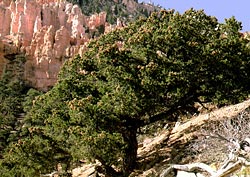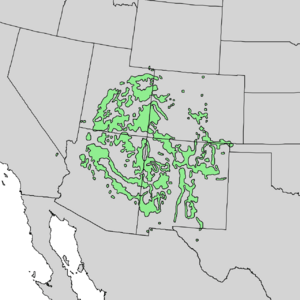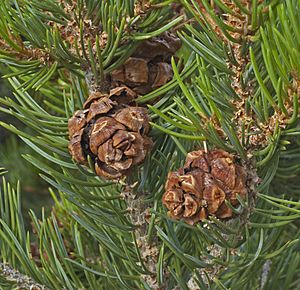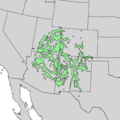Colorado pinyon facts for kids
Quick facts for kids Colorado pinyon |
|
|---|---|
 |
|
| Colorado pinyons at Bryce Canyon National Park | |
| Conservation status | |
| Scientific classification | |
 |
|
| Natural range of Pinus edulis |
The Colorado pinyon (also called two-needle piñon or pinyon pine) is a type of pine tree. Its scientific name is Pinus edulis. This tree is native to the United States. It comes from a group of ancient trees that could survive in dry places.
Contents
Where Colorado Pinyon Trees Grow
The Colorado pinyon tree grows in several states. These include Colorado, southern Wyoming, and parts of Utah. You can also find it in northern Arizona, New Mexico, and western Oklahoma. It even grows in southeastern California and the Guadalupe Mountains National Park in western Texas.
Pinyon's Mountain Home
These trees usually live at medium heights in the mountains. They are found between 5,200 and 7,900 feet (1,600 to 2,400 meters) high. Sometimes, they can grow as low as 4,600 feet (1,400 meters). They can also reach as high as 9,800 feet (3,000 meters).
Pinyon-Juniper Forests
Colorado pinyons are very common in these areas. They often form large, open forests. These forests are usually mixed with juniper trees. This type of forest is called a Pinyon–juniper woodland. In Colorado, the pinyon is the main tree in 4.8 million acres (19,000 square kilometers) of forest. This makes up 22% of the state's forests.
Pinyon's Role in History
Long ago, the strong wood of the pinyon tree was important for farming. Early settlers in Colorado used "plow heads" made from pinyon wood. These helped them break the soil for planting crops.
Unusual Pinyon Locations
There is one special Colorado pinyon tree. It grows at a very high elevation of almost 10,400 feet (3,170 meters). This tree is on Kendrick Peak in northern Arizona. It grows alongside Engelmann spruce and limber pine trees.
What Colorado Pinyon Trees Look Like
The Colorado pinyon is a small to medium-sized tree. It usually grows to be 10 to 20 feet (3 to 6 meters) tall. Its trunk can be up to 30 inches (80 cm) wide. The bark of the tree is rough and scaly.
Pinyon Needles and Cones
The leaves of the pinyon are called needles. They grow in pairs. Each needle is about 1 to 2 inches (3 to 5.5 cm) long. They are green and have tiny pores called stomata on both sides.
The cones of the pinyon are round. They are about 1 to 2 inches (3 to 5 cm) long and wide when closed. They start green and turn yellow-brown after about 18 to 20 months. The cones have only a few thick scales. When mature, they open up to 1.5 to 2.5 inches (4 to 6 cm) wide. They hold the seeds on their scales.
Pinyon Seeds
The seeds inside the cones are about 0.4 to 0.5 inches (10 to 14 mm) long. They have a thin shell and a white inside part called an endosperm. They also have a tiny wing, about 0.04 to 0.08 inches (1 to 2 mm) long.
Aromatic Qualities
The Colorado pinyon tree has a strong, pleasant smell. You can get essential oil from its trunk, branches, needles, and cones. This oil contains many fragrant compounds.
How Colorado Pinyons Live
The seeds of the Colorado pinyon are very important for animals. The pinyon jay bird helps spread the seeds. It pulls the seeds out of the open cones and stores them for food. Many of these stored seeds are not eaten. Instead, they grow into new pinyon trees. Wild turkeys, Montezuma quail, and different mammals also eat the seeds.
History of the Colorado Pinyon
George Engelmann first described the Colorado pinyon in 1848. He found it near Santa Fe, New Mexico. This was during an expedition to northern Mexico in 1846.
Related Pinyon Species
The Colorado pinyon is closely related to the Single-leaf pinyon. Sometimes, these two types of trees can mix and create new trees where their ranges meet. This happens in western Arizona and Utah. It is also related to the Texas pinyon. However, they are separated by about 60 miles (100 km), so they do not mix.
Some trees in the New York Mountains of California were once thought to be Colorado pinyons. But scientists now know they are a type of single-leaf pinyon with two needles. Also, some two-needled pinyons in northern Baja California, Mexico, are actually mixes of single-leaf pinyon and Parry pinyon.
Uses of the Colorado Pinyon
The seeds of the Colorado pinyon are called pine nuts. They are edible and are gathered a lot. In many places, Native American tribes own the rights to harvest these seeds. The pinyon tree is very important to their culture and economy. The unshelled seeds can be stored for up to a year. Some old stories say that the "tree of life" is a pinyon pine. This tree is rooted in ancient cultural sites in pinyon areas of Colorado.
Pinyon in Ancient Homes
Archaeologist Harold S. Gladwin studied ancient homes built by Native Americans. These homes were called pit-houses and were built around 400–900 CE. The walls of these homes were made stronger with posts from pinyon trunks. They were then covered with mud.
Pinyon as a State Symbol
The Colorado pinyon (Pinus edulis) is the state tree of New Mexico. It is sometimes planted as a decorative tree. It is also used as a Christmas tree.
Images for kids
-
Colorado pinyons at Bryce Canyon National Park
See also
 In Spanish: Pinus edulis para niños
In Spanish: Pinus edulis para niños






